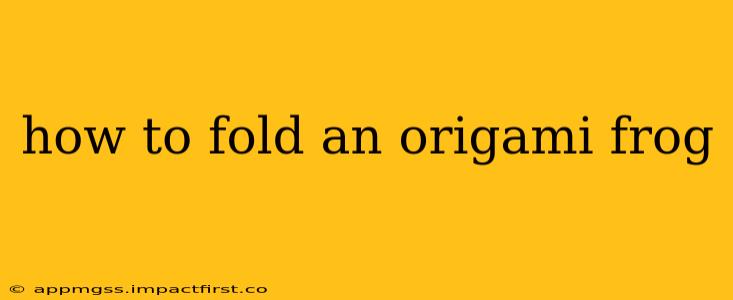Origami frogs are a classic and fun origami project, perfect for beginners and experienced folders alike. This guide will take you through the steps, answering common questions along the way, to help you create your own hopping origami amphibian.
What kind of paper do I need for an origami frog?
The best paper for origami frogs is square paper, typically around 6 inches (15cm) for a good-sized frog. You can use origami paper specifically designed for folding, which comes in a wide variety of colors and patterns. However, any square piece of thin paper will work, even printer paper (though it might be slightly less durable). Avoid using thick cardstock, as it will be difficult to fold sharply.
How many steps are there to making an origami frog?
The exact number of steps varies depending on the specific instructions you follow, but most origami frog diagrams involve between 10 and 20 distinct folds. Don't be intimidated by the number of steps – each fold is relatively simple, and with a little patience, you'll be able to create a perfect frog.
What are the different ways to make an origami frog?
While the basic origami frog design remains consistent, there are slight variations you might encounter. Some instructions might emphasize a more rounded frog body, while others focus on a more slender design. The differences are usually minor and affect the final aesthetic rather than the fundamental folding techniques. You might also find variations that incorporate extra details, such as eyes or patterned skin.
Step-by-Step Instructions: A Simple Origami Frog
While visual diagrams are often the best way to learn origami, I will provide a textual description for those who prefer this method. Remember to fold crisply and accurately for the best results. For the best visual guidance, search online for "origami frog instructions" – many excellent video tutorials are available.
Step 1: The Base
Start with a square piece of paper. Fold it in half diagonally, crease well, and unfold. Repeat this for the other diagonal. This creates a clear "X" on your paper.
Step 2: Forming the Triangles
Fold each corner to the center point where your "X" intersects, creating four smaller triangles.
Step 3: Creating the Legs
Fold the top layer of each of the four resulting triangles downwards, towards the center.
Step 4: The Body Shape
Fold the entire model in half along the original horizontal crease.
Step 5: Leg Refinements
Gently unfold the bottom corners. Pull out the legs to shape them and create the frog's "legs."
Step 6: The Finishing Touches
Fold the upper part of the model to create the frog's head and neck. You can further refine the details of the head and legs to create a more realistic or stylized frog.
How do I make my origami frog jump?
This is the fun part! Once your frog is complete, gently press down on the back. Then, pull the back of the frog upwards. With practice, a well-folded frog will hop quite convincingly!
Can I use different types of paper for an origami frog?
While thinner papers are generally preferable, you can experiment with different weights and textures. Heavier papers might require more effort to fold, resulting in a more sturdy but possibly less graceful frog. Metallic papers, patterned papers, or even newspaper can create unique effects.
This guide provides a foundational understanding of how to fold an origami frog. Experiment, explore different folding techniques, and enjoy the process of creating your own hopping friend! Remember that practice makes perfect, so don't be discouraged if your first attempt isn't perfect. Keep trying, and you'll soon be mastering the art of the origami frog.
